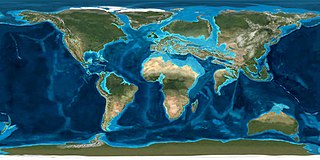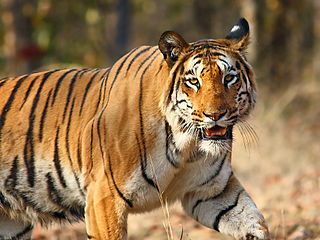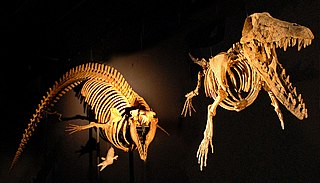
The Cenozoic Era meaning "new life" is the current and most recent of the three geological eras of the Phanerozoic Eon. The Cretaceous–Paleogene extinction event is the boundary between preceding Mesozoic era and the Cenozoic, which extends from 66 million years ago to the present day. Many species, including all non-avian dinosaurs, became extinct, in an event attributed by most experts to the impact of a large asteroid or other celestial body, the Chicxulub impactor.

The Eocene Epoch is a geological epoch that lasted from about 56 to 33.9 million years ago (mya). It is the second epoch of the Paleogene Period in the modern Cenozoic Era. The name Eocene comes from the Ancient Greek ἠώς and καινός and refers to the "dawn" of modern ('new') fauna that appeared during the epoch.

The Lepidosauria are reptiles with overlapping scales. This subclass includes Squamata and Rhynchocephalia. It is a monophyletic group and therefore contains all descendants of a common ancestor. Squamata includes snakes, lizards, and amphisbaenia. Rhynchocephalia was a widespread and diverse group 220-100 million years ago; however, it is now represented only by the genus Sphenodon, which contains a single species of tuatara, native to New Zealand. Lepidosauria is the sister taxon to Archosauria, which includes Aves and Crocodilia. Lizards and snakes are the most speciose group of lepidosaurs and, combined, contain over 9,000 species. There are many noticeable distinguishing morphological differences between lizards, tuataras, and snakes.

Polychrus is the only extant genus of polychrotid lizards in the world. Commonly called bush anoles, they are found in Central and South America, as well as nearby Trinidad and Tobago.

|thumb]]

Archaeoceti, or Zeuglodontes in older literature, is a paraphyletic group of primitive cetaceans that lived from the Early Eocene to the late Oligocene. Representing the earliest cetacean radiation, they include the initial amphibious stages in cetacean evolution, thus are the ancestors of both modern cetacean suborders, Mysticeti and Odontoceti. This initial diversification occurred in the shallow waters that separated India and Asia 53 to 45 mya, resulting in some 30 species adapted to a fully oceanic life; though both echolocation and filter-feeding evolved during a second radiation 36 to 35 mya.

Herpetotheriidae is an extinct family of metatherians. Although sometimes placed in the living opossum family, they may form the sister clade to all living marsupials. Species of this family are generally reconstructed as terrestrial. Fossils of herpetotheriids come from North America, Asia, Europe, Africa, and perhaps South America. The oldest representative is Maastrichtidelphys from the latest Cretaceous (Maastrichtian) of the Netherlands and the youngest member is Amphiperatherium from the Middle Miocene of Europe.
The Paleocene, or Palaeocene, is a geological epoch that lasted from about 66 to 56 million years ago (mya). It is the first epoch of the Paleogene Period in the modern Cenozoic Era. The name is a combination of the Ancient Greek palæo- meaning "old" and the Eocene Epoch, translating to "the old part of the Eocene".

Remingtonocetidae is a diverse family of early aquatic mammals of the order Cetacea. The family is named after paleocetologist Remington Kellogg.
Susan E. Evans is British palaeontologist and herpetologist. She is the author or co-author of over 100 peer-reviewed papers and book chapters.
Bahndwivici is an extinct genus of lizard known from a nearly complete and articulated skeleton discovered in rocks of the Green River Formation of Wyoming, United States. The skeleton is very similar to that of the modern Chinese crocodile lizard, Shinisaurus.
Afairiguana avius is an extinct iguanid lizard known from a nearly complete and articulated skeleton discovered in rocks of the Early Eocene-aged Green River Formation of Wyoming, United States. As of the initial description, the skeleton represents the oldest complete iguanian from the Western Hemisphere, and is the oldest representative of the extant iguanid family of anoles, Polychrotidae.

Barbaturex is an extinct genus of giant herbivorous iguanian lizards from the Eocene of Myanmar. It is represented by a single species, Barbaturex morrisoni, which is known from several partial dentaries and a fused pair of frontals, two bones that form part of the top of the skull. Based on the size of these bones, Barbaturex morrisoni is estimated to have been about 1 metre (3.3 ft) from snout to vent, and possibly up to 6 feet (1.8 m) including the tail. Barbaturex morrisoni was named after The Doors frontman Jim Morrison, a play on his epithet "The Lizard King". The genus's name is a portmanteau of the Latin words Barbatus and rex, meaning "bearded king", in reference to ridges along the mandible and the lizard's large size.
Suzanniwana is an extinct genus of iguanian lizards that lived in western North America during the earliest Eocene, approximately 56 million years ago. Two species are known from the Bighorn Basin of Wyoming: the type species S. patriciana named in 2009, and the species S. revenanta named in 2013. Suzanniwana lived during the Paleocene–Eocene Thermal Maximum, a brief period of global warming that resulted in warmer and drier conditions in the Bighorn Basin. It likely stemmed from a lineage that had migrated into the basin from regions farther to the south, following a latitudinal band of constant climatic conditions that moved northward as the planet warmed. Suzanniwana shares many skeletal features with modern casquehead lizards of the family Corytophanidae and may be a stem-corytophanid. It also closely resembles Geiseltaliellus, an iguanian from the middle Eocene Messel pit in Germany.
Anolbanolis is an extinct genus of iguanian lizards that lived in the Bighorn Basin of what is now Wyoming during the earliest Eocene. The type species A. banalis was named by paleontologist Krister Smith in 2009 from a collection of isolated skull fragments found in a layer of the Willwood Formation that dates to a brief period of global warming called the Paleocene-Eocene thermal maximum (PETM) about 56 million years ago. The genus name Anolbanolis means "poor anole" from the Greek anolbos and the name Anolis, in reference to the scrappy nature of known fossil material and its close resemblance to lizards in the genus Anolis. Smith suggested that Anolbanolis may be a close relative of Anolis or Polychrus, which are common today in Central and South America but not found as far north as Wyoming, fitting with the idea that the Bighorn Basin was warmer and wetter in the Eocene than it is currently. According to Smith, the species name banalis is a reference to it being a "banal" lizard in the Willwood, being "quite abundant in the type locality," and not unusual because "the discovery of Eocene boreal fossil members of living subtropical and tropical clades is becoming commonplace." In 2011 Smith named a second species of Anolbanolis, A. geminus, which lived in the Bighorn Basin shortly after the PETM and was about 50 percent larger than A. banalis. Smith concluded on the basis of features in A. geminus that Anolbanolis is more closely related to Anolis than it is to Polychrus.
Babibasiliscus is an extinct genus of casquehead lizard that lived in what is now Wyoming during the early Eocene, approximately 48 million years ago. The genus is known from a single species, Babibasiliscus alxi, which was named by paleontologist Jack Conrad in 2015 on the basis of a fossilized skull from the Bridger Formation in the Green River Basin. The name Babibasiliscus comes from the Shoshoni word babi, meaning "older male cousin", and Basiliscus, a modern-day genus of casquehead lizards. The specimen is undeformed and nearly complete except for the tip of the snout and the top of the skull, making it unclear whether the distinctive bony crest of living corytophanids was present in prehistoric relatives like Babibasiliscus. The skull is about 42 millimetres (2 in) in length and the entire body is estimated to have been about 0.6 metres (2 ft) long. Bones on the right side of lower jaw of the specimen are thickened and fused together, suggesting that the jaw had broken and healed when the animal was alive.
Indiagama is an extinct genus of agamid lizard known from the type species Indiagama gujarata from the early Eocene of India. Indiagama was named in 2013 on the basis of a single lower jaw from the Cambay Shale in Gujarat. The rectangular shape of its teeth distinguish it from all other agamids, living and extinct.
Priscagamidae is an extinct family of iguanian lizards known from the Late Cretaceous of Mongolia and China and the Eocene of India, spanning a range from 75 to 54 million years ago. It includes the genera Heterodontagama, Mimeosaurus, Phrynosomimus, Priscagama, and possibly Pleurodontagama. The first fossils of priscagamids were found in the Djadochta and Khermeen Tsav formations of Mongolia. More recently they have been found in the Cambay Formation in India, leading to the naming of Heterodontagama in 2013. Priscagamidae was originally described as a subfamily of Agamidae called Priscagaminae in 1984, but it was reclassified as a distinct family in 1989. Most phylogenetic analyses still find a close relationship between Priscagamidae and Agamidae, although a 2015 study found it to be basal to all other iguanian clades, warranting its removal from Iguania and placement in a larger clade called Iguanomorpha.
Heterodontagama is an extinct genus of iguanian lizard from the Early Eocene of India. It belongs to the extinct family Priscagamidae, which is otherwise only known from the Late Cretaceous of Mongolia. The type species Heterodontagama borsukae was named in 2013 from several isolated upper and lower jaws found in an exposure of the Cambay Shale in an open-pit coal mine in Gujarat.
Geiseltaliellus is an extinct genus of iguanian lizards that lived in what is now western Europe during the Eocene. It belongs to the family Corytophanidae, which includes modern casquehead lizards. Many fossils are known from Germany, France, and Belgium, with the most well preserved coming from the Messel pit lagerstätte in Messel, Germany. German paleontologist Oskar Kuhn named the genus in 1944 after the Geiseltal valley where the first specimens were found, designating the type species Geiseltaliellus longicaudus. Three new species — G. louisi, G. lamandini, and G. grisolli — were named in the 1990s and 2000s on the basis of more fragmentary remains from France and Belgium, although G. louisi has since been synonymized with G. longicaudus. In 2009 the Messel pit specimens were recognized as belonging to a species distinct from that of the G. longicaudus specimens in Geiseltalt and were collectively reclassified under a new name, G. maarius.








